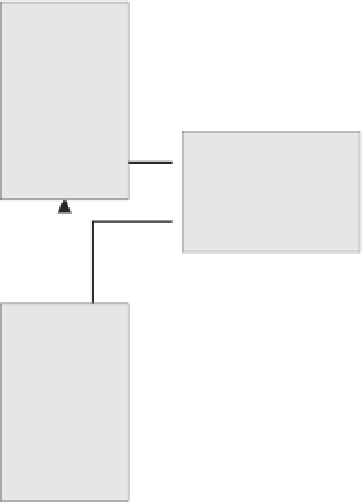Environmental Engineering Reference
In-Depth Information
Human
influences:
External
sanitation
measures:
External nutrient inputs
Wastewater
treatment,
Industry,
agriculture,
recreation,
others
sewage
diversion
Point
sources
Non-
point
sources
LAKE
RECOVERY
Wind, light,
temperature
Internal nutrient
loading
Limnological
characteristics
Inlake
restoration
Hydrology
(nutrient
decrease)
LAKE
Lake's
morphometry,
geology
Biomanipulation
Figure 18.4
Schematic representation of factors causing an increase in nutrient loading via external inputs, which also
result in an increase of internal loading, and restoration measures (white boxes) leading to lake recovery. (From Gulati 1989 .)
animal wastes (>95% P removal) was the main
P-control measure. Most importantly, P-containing
laundry detergents were replaced by P-free detergents
in most western countries. This led to about 50%
reduction of P input into some lakes in the United
States. In Barton Broad, Norfolk, United Kingdom,
about 90% of the annual P load in the effl uent from
sewage treatment works was reduced by adding ferric
sulphate (iron binds P and the Fe-P product precipi-
tates to the bottom). However, because the bottom con-
tained so much residual P as a result of decades of
eutrophication, this P started to mobilize from the
bottom into the water column blocking the hoped-for
improvement in water quality (Phillips
et al
. 1994 ).
The response of algae to restoration measures can
greatly differ among lakes: whereas some lakes improve
in water quality (i.e the water transparency depth
increases because of a reduction in concentration of
algae), the others exhibit a small reduction of algal
biomass, and still others show no reduction at all
in algal biomass. In lakes in the Netherlands and
Denmark, the P-reduction measures undertaken over
recent decades have generally reduced concentrations
of both P and chlorophyll (indicating algal biomass),
and thereby improving water transparency. However,
P retention in lake sediments, and its subsequent
release (internal P loading), retarded the lakes' response
to P reduction measures (Ibelings
et al
. 2007 ; Jeppesen
et al
. 2007a; Figure 18.5). Thus, the observed variation
in responses of lakes to P-reduction measures depends
on the amount of P that is stored in the sediments.
Phosphorus from external inputs may also be
removed by fi rst passing P-rich effl uents into treatment
ponds, where much of the P is adsorbed on to sediments
and settles there. Also, most of the P released due to
lysis and death of algal blooms will be taken up by
the sediment. Regular harvesting of aquatic vegetation
(e.g. duckweeds,
Lemna
; water fern,
Azolla
; and other
fl oating plants) can signifi cantly reduce P (e.g. Viess-
man & Hammer 1993). To reduce nonpoint P loading,
agricultural farming practices in a lake's catchment
area need to be altered radically by preventing erosion,
and rationalizing the frequency, amount and timing of
fertilizer applications. In addition, creation of pasture
land and planting of buffer strips between farmland
and watercourses may help reduce P.
The route to recovery or restoration of lakes (i.e. from
eutrophication back to nutrient-poor conditions) takes



















